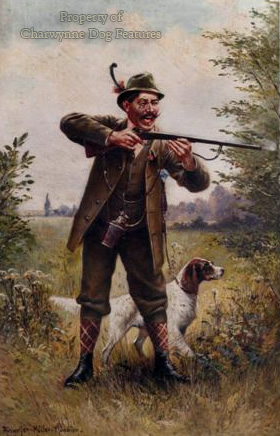470 German HPRs
PRAISING THE TEUTONS
by David Hancock
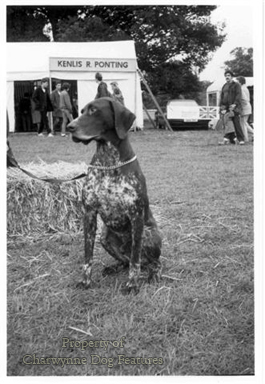
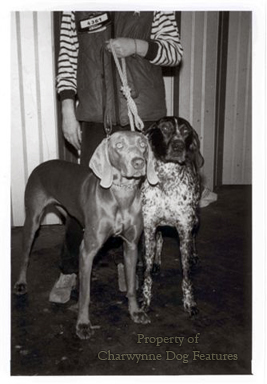
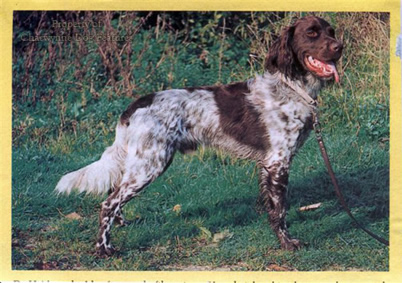

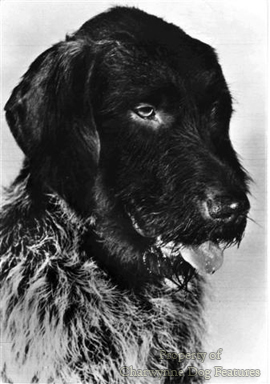 I have lived in Germany three times, each time in a different part. The local German sportsman in each location favoured a different breed of gundog, ranging from the Langhaar and the GWHP to the Korthals Griffon and the Small Munsterlander. If I had imported a gundog from Germany after each of these experiences, it would have been a different breed each time. Location as well as the merit of the dogs would have played a part. Some German sportsmen too favoured British gundogs. But I was able to assess breeds like the four varieties of German pointer, by name, including the less well known Stichelhaar or 'bristle-haired' pointer, stichel being linked to our word stickle, as in stickle-back. I didn't see the Pudelpointer at work, but did see the German 'spaniel', the workmanlike Wachtelhund, or quail dog. I was told of a lost breed, the 'dreifarbiger Wurttemberger', a tricolour coarse-haired pointer once favoured in the south and likely to have been subsequently subsumed by a sister gundog breed.
I have lived in Germany three times, each time in a different part. The local German sportsman in each location favoured a different breed of gundog, ranging from the Langhaar and the GWHP to the Korthals Griffon and the Small Munsterlander. If I had imported a gundog from Germany after each of these experiences, it would have been a different breed each time. Location as well as the merit of the dogs would have played a part. Some German sportsmen too favoured British gundogs. But I was able to assess breeds like the four varieties of German pointer, by name, including the less well known Stichelhaar or 'bristle-haired' pointer, stichel being linked to our word stickle, as in stickle-back. I didn't see the Pudelpointer at work, but did see the German 'spaniel', the workmanlike Wachtelhund, or quail dog. I was told of a lost breed, the 'dreifarbiger Wurttemberger', a tricolour coarse-haired pointer once favoured in the south and likely to have been subsequently subsumed by a sister gundog breed.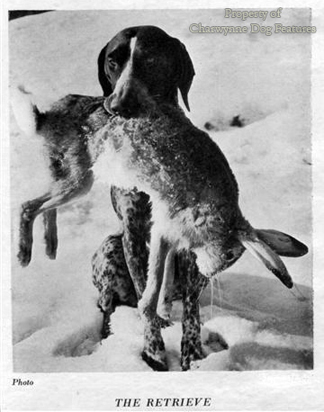
In Germany, like Hungary, pointing dogs were produced in smooth, coarse and long-haired varieties, to give us the pointer breeds from Germany and Vizsla varieties of today. According to Wenze, the Vizsla was known in the region of the kings of the House of Arpad (11th to 14th centuries) but was used as an all-purpose hunting dog until the late 19th century. At that time, the German pointer was being standardised through Hector I and Waldin, a whole-coloured brown dog. The Weimaraner, like the Vizsla, was initially used as a multi-purpose hunting dog, for tracking deer and boar, for instance. Liver-roan smooth-haired pointing dogs were not however confined to Germany, as the French pointers indicate.
The coarse-haired pointers, favoured in Germany, Italy, Hungary and what is now the Czech republic, had a reputation for greater hardiness and persistence. There are distinct similarities between the Hungarian coarse-haired griffon, the drotszoruvizsla, the Cesky Fousek and the Korthals Griffon. Korthals developed his variety from German and French breeds including the Barbet, avoiding the use of hound blood which brought with it contrasting instincts and temperament. He was Dutch-born, but lived in Biebesheim, hunting in the marshes between the Rhine and Main rivers. In the 1870s he began with seven rough-haired dogs, obtained in France, Germany and Holland. He eventually produced a number of superlative hunting dogs, with superb stamina, remarkable scenting powers and hard bristle-textured waterproof coats. This has led to the blood of this breed being used again and again in the breeding of German Wire-haired Pointers. 
In the 1980s there was widespread prejudice against the 'Hunt, Point and Retrieve' breeds (HPRs) or continental all-rounders, in Britain, led by two leading gundog writers of that time, in the foremost gundog magazine of that time. One of these writers, in an article tendentiously entitled 'The Teutons', wrote: "I do not want an HPR...Nevertheless, I can see that the German dogs have their uses..." Such damning with faint praise didn't prevent more open-minded British sportsmen from taking on 'The Teutons'. In 1984, 740 German short-haired pointers and 893 Weimaraners were registered with the KC. In 2003, 1,406 GSPs and 2,978 Weimaraners were registered here. These all-rounders were evidently here to stay.
In 1989, Tony Jackson edited a new book 'Hunter-Pointer-Retriever' (Ashford), beautifully illustrated by Marion Jones, which did much to spread the word. Before that, writer-photographer David Layton's book 'All Purpose Gundog' (Standfast) did much to explain the differing training needs of the HPR breeds, and they are different. The German pointers have found favour with rough-shooters here. The rough-shooter expects his dog to range wide or close according to the terrain, confirmed by the handler's signals. The dog is expected to be a ground-scenter and an air-scenter, a soft-mouthed retriever and a gamefinder. It should be capable of holding game on point until its handler is within range and then flush it. It must be able to work with equal ability in water, dense cover or in open country.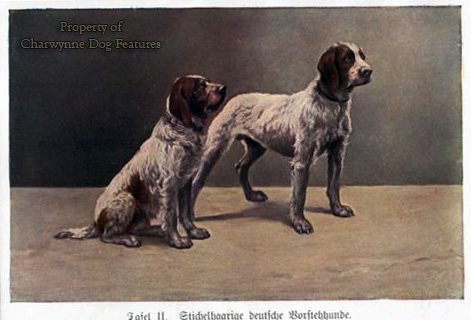
It is hardly surprising that a dog which has to adapt its range, head-height and pace, and then find, point and retrieve shot game, is open to criticism from purist pointer users. It is unreasonable to expect such a wide repertoire to be instilled easily or perfected effortlessly in such a gundog. The all-rounders demand more time and more enlightened handling; they are not utility dogs for tyro-sportsmen but complex dogs for knowledgeable rough shooters. The HPR breeds show early signs of instinctive behaviour yet mature slowly. A German short-haired Pointer at one year is very different from, say, a Labrador of that age. Professional trainers are therefore given less scope and this could result in talented amateur owner-handlers, able and willing to devote more time to their dogs, excelling with HPR breeds.
This slowness to mature must never be confused with stupidity or lack of innate ability. Here is a group of dogs that can follow wounded game or track deer and boar, work with the falcon, quarter ground close or wide, hold game on point, flush on command, mark and retrieve shot game, work in water and dense cover, withstand the cold and the wet, and yet provide companionable loyalty and affection for their owners. These highly versatile dogs were developed in a stern demanding school by experienced sportsmen over several centuries. We should recognise and enjoy their special talents and their spiritual needs.
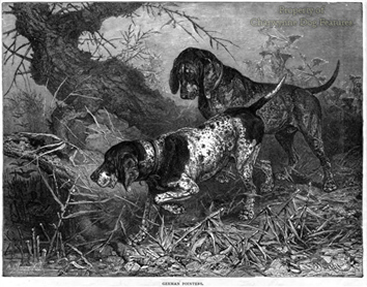

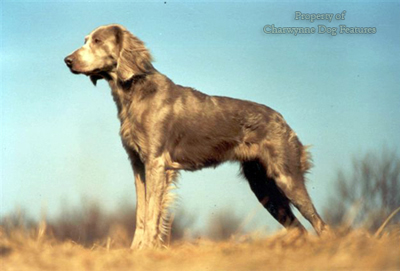
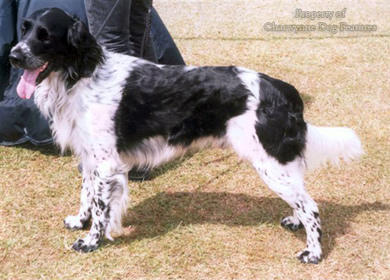
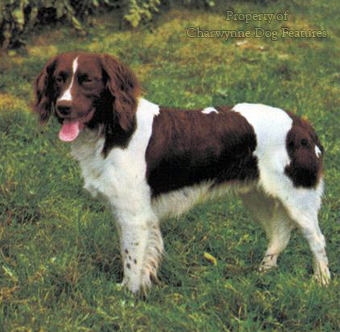 The early imports in each German pointer breed came from working stock, you could see this in their conformation and uniformity of type. Since then I suspect that the show dogs have separated from the dogs expected to work. I now see in the ring dogs with too short a back, over-boned specimens, coarse dogs with loose movement in front and, increasingly, short upper arms. The set of tail seems to vary widely and the coats in the wire-haired entry defy the breed standard, which states that the coat should lie close to the body, with the outer coat thicker and harsh. Coat colour seems to be accompanied by other genetic tendencies. In the GWHPs the solid livers and mainly blacks tend to have shorter coats than the liver and whites.
The early imports in each German pointer breed came from working stock, you could see this in their conformation and uniformity of type. Since then I suspect that the show dogs have separated from the dogs expected to work. I now see in the ring dogs with too short a back, over-boned specimens, coarse dogs with loose movement in front and, increasingly, short upper arms. The set of tail seems to vary widely and the coats in the wire-haired entry defy the breed standard, which states that the coat should lie close to the body, with the outer coat thicker and harsh. Coat colour seems to be accompanied by other genetic tendencies. In the GWHPs the solid livers and mainly blacks tend to have shorter coats than the liver and whites.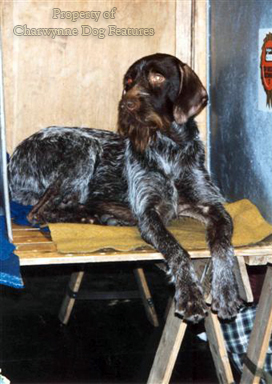
In GSPs the 'white factor' or white body, liver head and pink pads, has cropped up here as well as in the USA. The tricolours, defined as 75% black, 10% liver and 15% white, considered highly undesirable both in GSPs and GWHPs, have been described by one coat-colour expert geneticist as 'impossible'! The colour black still excites discussion in the GSP world. In the 1920s, Christian Bode, with his Altenauer strain, became concerned about poor pigmentation in his stock, mainly yellow eyes and pale faded coats. He introduced the blood of a black Pointer to rectify this, with success, although objections to this coat colour in GSPs continues today, especially in America. His dogs were once referred to as Prussian shorthairs and his methods illustrate the value of improvement in defiance of dogma, perennially needed in breeding animals but rarely seen in the world of the pure bred dog today.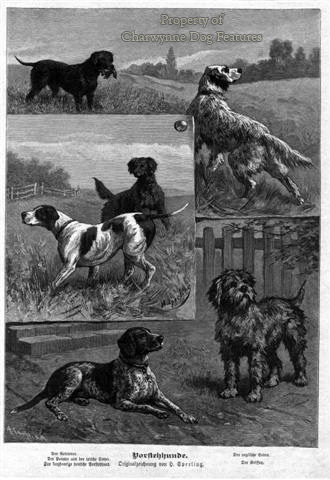
Prejudice about colour influenced the emergence of the Munsterlander, especially the large variety. Originating in Munsterland in Prussia rather than the land around Munster further south, as often claimed, this distinctive breed was born from bias against black Langhaars. The latter were often given to farmers and not favoured by sportsmen, some of whom disputed their 'pure German' blood, because they were not the more acceptable liver-brown. At one time the blue roan coats were not desired in Large Munsterlanders and solid black heads preferred. The weird world of coat colour preferences in breeds of dog will always exasperate me. Give me an outstanding dog and I'll tell you my preferred colour as an afterthought.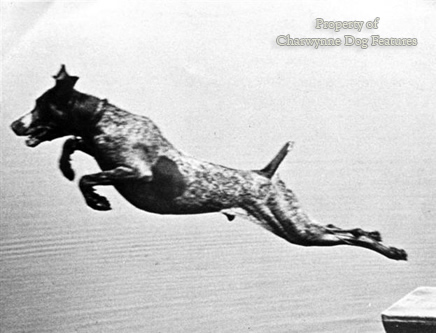
The Langhaar is gaining ground in Britain; it may look like a setter but works as an all-rounder. In Holland it is the favoured wildfowlers' dog. A Dutch Langhaar won the title of World Field Trial Champion in Spain some twenty years ago. It is an extremely handsome breed with an admirably wide range of coat colours. Combining handsomeness with usefulness has long been man's desire in breeds of dog. The German gundogs have always had to earn their keep and I hope British fanciers will honour this heritage. Maxine O'Connor writing in Countryman's Weekly nearly five years ago stated that "...if we do not breed from correctly constructed, strong GWPs with good coats and correct mouths that are capable of working, then tragically the breed will become as Labradors and Springers - a show/working split." Her GWHP won Crufts that year and her words apply, not just across the German gundog breeds but across gundog breeds of every country. The German gundog breeds once sneered at as 'Teutons' are here on merit and deserve to be perpetuated as highly competent working dogs - and handsome ones too.
